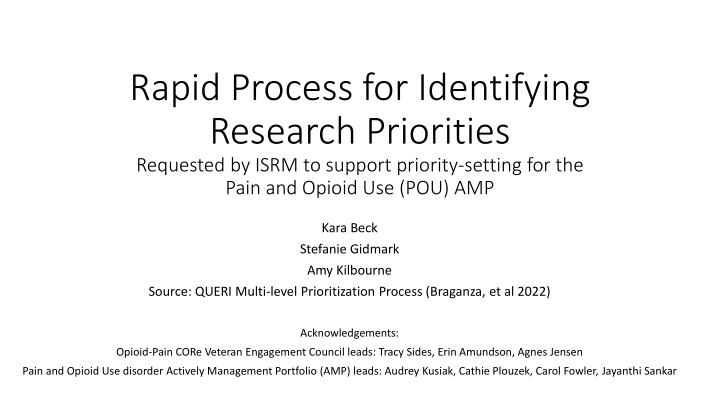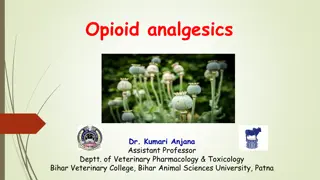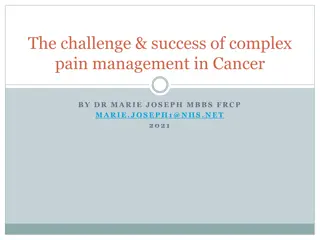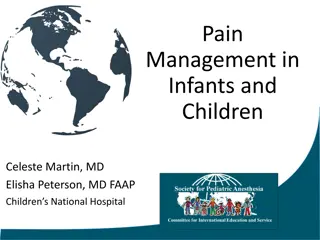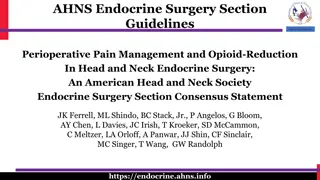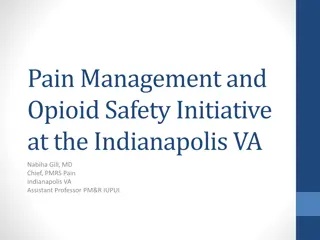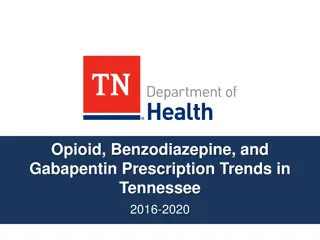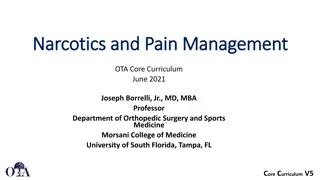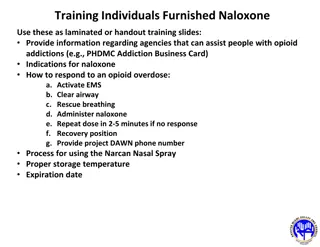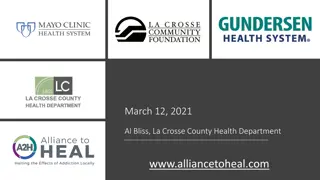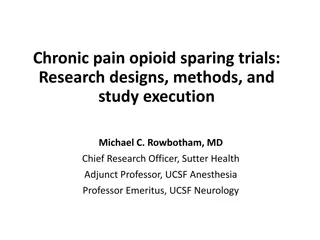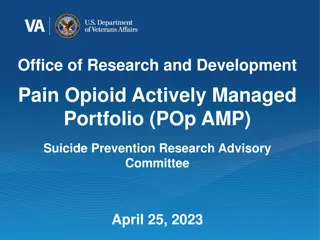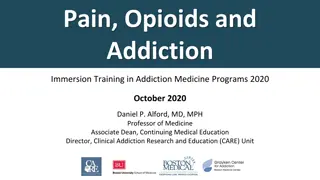Rapid Process for Identifying Research Priorities in Pain and Opioid Use
The Rapid Process for Identifying Research Priorities in Pain and Opioid Use involved a systematic approach to determining research gaps and unanswered questions in the Pain and Opioid Use domain. Through a multi-level prioritization process and engagement with various stakeholders, emphasis was placed on urgency, impact, feasibility, and identifying impact metrics. This process incorporated feedback from focus groups, surveys, and Delphi consensus panels to refine research priorities for the Pain and Opioid Use portfolio. General principles guiding the prioritization process included considering the research translation spectrum, obtaining diverse perspectives, and measuring impact effectively.
Download Presentation

Please find below an Image/Link to download the presentation.
The content on the website is provided AS IS for your information and personal use only. It may not be sold, licensed, or shared on other websites without obtaining consent from the author.If you encounter any issues during the download, it is possible that the publisher has removed the file from their server.
You are allowed to download the files provided on this website for personal or commercial use, subject to the condition that they are used lawfully. All files are the property of their respective owners.
The content on the website is provided AS IS for your information and personal use only. It may not be sold, licensed, or shared on other websites without obtaining consent from the author.
E N D
Presentation Transcript
Rapid Process for Identifying Research Priorities Requested by ISRM to support priority-setting for the Pain and Opioid Use (POU) AMP Kara Beck Stefanie Gidmark Amy Kilbourne Source: QUERI Multi-level Prioritization Process (Braganza, et al 2022) Acknowledgements: Opioid-Pain CORe Veteran Engagement Council leads: Tracy Sides, Erin Amundson, Agnes Jensen Pain and Opioid Use disorder Actively Management Portfolio (AMP) leads: Audrey Kusiak, Cathie Plouzek, Carol Fowler, Jayanthi Sankar
Rapid (and Rigorous) Approach to Identifying AMP Research Priorities Rapid (and Rigorous) Approach to Identifying AMP Research Priorities Existing reviews inform focus group, survey questions Survey and focus group input inform Delphi consensus panel discussion with representatives from different groups Phase II: Refine Priorities using concurrent processes: national surveys/live voting & focus groups with Consumer, Provider, Leader, Investigator groups Phase I: Identify research gaps and unanswered questions (e.g., SPM review, evidence inventories or reviews, VA program office strategic plans) Phase III: Delphi consensus panel with interested party representatives rank priorities on urgency, impact, feasibility, identify impact metrics AMP Priorities for RFA References: 1. Aligning quality improvement efforts and policy goals in a national integrated health system - Braganza - 2022 - Health Services Research - Wiley Online Library; 2. Health System Research Priorities for Children and Youth With Special Health Care Needs - PubMed (nih.gov), 3. Research Lifecycle to Increase the Substantial Real-world Im... : Medical Care (lww.com) General principles: 1. Priorities should reflect the research translation spectrum (e.g., T1-T4) 2. In-depth feedback from focus groups to identify topics not previously listed 3. Broad representation across interested parties via surveys, voting on top priorities 4. Perspectives from the front line Measures of Impact Exec. Committee
Phase I: Pain and Opioid Use Research Priority Phase I: Pain and Opioid Use Research Priority- -setting Process setting Process 1. Reviewed initial List of POU AMP and CORe Priorities 2. Conducted brief Evidence Inventory to enhance initial list of priority topics, considering topic areas identified as gaps in existing priorities 3.Identified opportunities using existing lists of VA providers, leaders, and Veterans for focus groups and surveys on priority topics, especially from the front line e.g., 1.Clinical leader, mid-level manager focus group (VISN, VAMC) 2.Mid-level manager survey (VAMC), representing primary care, nursing, pain management, MH/SUD, neurology, pharmacy, rehabilitation, etc. 3.Veterans engagement councils
Phase I: Brief Evidence Inventory Using HSR&D Evidence Synthesis Phase I: Brief Evidence Inventory Using HSR&D Evidence Synthesis Program Method for POU AMP Research Priorities Program Method for POU AMP Research Priorities - - February 2023 February 2023 NIH Early-phase Pain Investigator Clinical Network program 2019 Review of currently available medication-focused treatments for neuropathic pain AHRQ Comparative Effectiveness Review on current literature on treatments (effects from current health care studies were mainly small and short term) Quinones, Sam. The Least of Us: True Tales of America and Hope in the Time of Fentanyl and Meth, 2021 Hall and Weier (2017) describing Lee Robins study on US military Vietnam Veterans Spiegel, 2015, research agenda from the U.S. Dept of Health and Human Services (2016) NIH s HEAL initiative current list of projects focused on social determinants of health-based interventions New technologies for pain treatment New PCORI-funded study involving patient focus groups, emphasize complementary and integrative medicine
Phase I: Suicide Prevention Priority-Setting 1. Are there existing priority lists that can inform the process (e.g. SPRINT research priorities)? Identify gaps in priority list and conduct Evidence Inventory CDC Suicide Prevention Research Priorities DHA 2020 Prioritized Research Gaps Report for Suicide Prevention Topics DOD Suicide Prevention Research Strategy Action Alliance Prioritized Research Agenda for Suicide Prevention White House Report on Mental Health Research Priorities Association for Psychological Science summary of science of suicide prevention American Psychological Association summary of new research in suicide prevention Meta-analysis of suicide risk factors NIMH Practice-Based Suicide Prevention Research Centers Systematic review of Evidence-Based strategies 3. Identify opportunities for surveys and focus groups using existing lists of providers, Veterans, leaders 2.
Phase II: General Approach to Priority Input Process Communicated to Groups (March- May 2023) Background: 1) VHA Research is updating its funding priorities related to pain and opioid use disorder 2) We are obtaining input from Veterans, providers, and clinicians 3) We are especially interested in your input on emerging areas of research that can help support Veterans experiencing pain and/or opioid use disorders Context: 1) We are looking for priorities across basic, clinical, health services, and policy research 2) Neuropathic and musculoskeletal pain 3) Opioids and emerging products and substances 4) Focus on improving and sustaining long-term outcomes Maximize efficiency via rapid, parallel input process, leveraging existing groups
Phase II: Existing Groups for Input VA Leaders/clinical managers Chief Medical Officers, Chief Nursing Officers, Select VAMC Chiefs of Staff VHA Chiefs of Staff National Virtual Meeting VHA National Pain Management Strategy Coordinating Committee Virtual Meeting VISN Pain Consultants Veterans Pain/Opioid CORE Veteran Engagement Council VA Minneapolis COIN Veteran Engagement Panel Members Substance Addiction and Recovery Veteran Engagement Board Meeting Providers PACT Pain Champions VHA National SUD Community of Practice Call Provider surveys Investigators Survey distributed to investigators identified by PoP AMP SPMs
Phase II: Initial List of Priorities 1. Experimental and observational interventions to reduce opioid use disorder 2. Studies identifying therapeutic targets for pain, tolerance, and/or opioid use disorder 3. Preclinical development of non-opioid therapies and mechanisms of action 4. Research on the risk factors, treatment, and prevention of opioid use disorders 5. Clinical treatments for long-term recovery from pain especially non-opioid treatments 6. Environmental and policy changes addressing social determinants to prevent opioid misuse 7. Examination of pharmacology treatments related to opioid use disorder 8. Clinical studies of genetic, anatomical, and behavioral bases of pain and opioid addiction 9. Implementation of treatments and approaches to enhance pain services 10. Other priority area not covered
Phase II: Veteran Engagement Councils Facilitators: Tracy Sides, Erin Amundson, and Agnes Jensen, with support from other Veteran Engagement Council staff Prior to focus groups, developed briefing slides and focus group script and updated priorities using plain language Focus group methods: Introductions, background, initial voting and further input on priorities Two breakout sessions to further discuss research priorities Any topics missed on the initial list Focus on VA benefits research Final voting on top 2 priorities
Veteran Engagement Council Briefing Slides: Types of Health Research Types of research along the path from the biology of health and disease to interventions that improve the health of individuals. Laboratory setting Real-world setting Health systems & policy Laboratory Research Clinical Research Purpose: Understand the biology of pain and addiction; discover new treatments for further testing in people Purpose: Test potential new treatments in patients; understand how they work in people Purpose: Understand how to best implement effective treatments in routine clinical care; how to improve programs and policies by taking social and economic factors into account Includes various types of clinical trials with patients to test safety, effectiveness, and short-term outcomes (i.e., usually 1 year or less) Includes studies in laboratories using cells, animals, computer simulations Includes studies that evaluate the long-term impact of treatments or look at how social/economic factors impact access/quality of health care
Facilitators developed more plain language framing of the priority options:
Phase II: Synthesize and Feed Back Input Make updates to priorities iteratively Meaningfully group key insights Identify agreement of priorities across groups Utilize input on priorities to develop consensus panel or SOTA
Key insights by group VA national leaders Time-sensitive needs: Impact of telemedicine policies on long term treatment of pain and opioid use disorder Health and health care disparities in pain treatment Interdisciplinary therapies that address cross-diagnostic conditions Veterans VA has an important role in researching non-Rx treatments Provider turnover (workforce) VA benefits and policy reform (more flexibility in using educational benefits), drug courts, co-occurring conditions (SUD) Understanding the effects of medication on the body
Updated List of Priorities: Input from All Groups Basic/Clinical Health Services/Policy Experimental and observational studies of new models of care to improve outcomes related to opioid use disorder Environmental, social, and policy changes addressing social determinants to prevent opioid misuse (including policies related to telehealth/virtual care, Veterans benefits, jail diversion programs, etc.) Studies identifying new therapeutic targets for pain, tolerance, and/or opioid use disorder Research on the harms, risk factors, treatment, and prevention of opioid use disorders Preclinical studies of non-opioid therapies and mechanisms of action Research to understand the relationship between changes in opioid availability and accidental overdose risk Clinical studies of genetic, anatomical, and behavioral bases of pain and opioid addiction Evaluation of current pharmacology treatments and functional outcomes related to pain Clinical treatments for long-term recovery from pain, especially non-opioid treatments Implementation of treatments and approaches to enhance pain treatment services, especially for underserved groups Studies that seek new ways to identify and measure outcomes that matter most to Veterans Other priority not listed Other priority not listed
Overall Summary Priorities ranked highly by all categories of groups: Studies identifying new therapeutic targets for pain, tolerance, and/or opioid use disorder Clinical treatments for long-term recovery from pain, especially non-opioid treatments Priorities ranked highly by three groups: Leaders, providers and Veterans: Environmental, social, and policy changes addressing social determinants to prevent opioid misuse (including policies related to telehealth/virtual care, Veterans benefits, jail diversion programs, etc.) Providers, Veterans, and investigators: Implementation of treatments and approaches to enhance pain treatment services, especially for underserved groups Research on the risk factors, treatment, and prevention of opioid use disorders
Phase III: Consensus Panel/SOTA Present feedback on priorities to experts and interested parties Obtain input and high-level summary of key priorities to move forward on: Identify both short-term and long-term priorities Utilize input to develop and/or update RFAs
Phase III: Pain and Opioid Use Disorder AMP List of Priorities Phase III: Pain and Opioid Use Disorder AMP List of Priorities July 19 July 19- -20, 2023 Planning SOTA 20, 2023 Planning SOTA Critical Research Priorities Voting Results Ranking (Descending) Rationale Management of Chronic Pain and Opioid use Improving lifestyle choices and pharmacotherapies to reduce morbidity and mortality Pain Management Team Can result in the best combination of inputs from varying specialists that will help the patient Screening Predictive Analytics + Biomarkers Will aid in identifying who will respond to pharmacological treatments as well as other treatment modalities; Can also determine what treatment combinations would be fruitful It is VA Mission to optimize the well-being of the patient; can provide an alternative to patients with risk of developing OUD Non-Pharmacological Approach Harm Reduction services program; treatment goals involve those that reduce pain medication and not complete abstinence Harm Reduction Alternatives to pain treatment can lead to harm reduction, and safe and appropriate combined techniques/technology could offer better pain treatment modalities Pharmacological Alternatives 20
Next Steps Updated multi-level research priorities based on the QUERI process presented to POU-AMP SOTA meeting July 19-20, 2023 which included national researchers and VHA clinical leaders Amend Broad RFAs to include areas of special emphasis based on POU-SOTA and White House fentanyl and xylazine initiative Craft Focused RFAs based on top clinically relevant critical research priorities Obtain input from clinical partners and approval of RFAs from ISRM Friedhelm Sandbrink, Jennifer Murphy: Pain Management, Opioid Safety and Prescription Drug Monitoring Joseph Liberto, Dominick De Philippis, Ashley Engles Office of Mental Health and Suicide Prevention Fran Cunningham, Office of Pharmacy and Benefits Management Lucille Burgo and Michael Saenger, Office of Primary Care Benjamin Kligler, Office of Patient Centered Care and Cultural Transformation Joel Scholten, Office of Physical Medicine and Rehabilitation Mark Havran, Office of Physical Therapy POU-AMP to identify priorities to inform 2023 NIH-DOD-VA Pain Management Collaboratory RFA ISRM recommends future application of QUERI process to other AMPs and broad portfolios to identify long-term as well as short-term priorities
Status of Pain/Opioid AMP RFAs Status of Pain/Opioid AMP RFAs Priorities ranked highly by all categories of groups: Studies identifying new therapeutic targets for pain, tolerance, and/or opioid use disorder this is an original area of interest for the Broad RFA. Added special emphasis on development of xylazine reversal medication(s). Clinical treatments for long-term recovery from pain, especially non-opioid treatments this will be a focused RFA especially for pain management/OUD in underserved groups, including LTOT/OUD. Priorities ranked highly by three groups: Leaders, providers and Veterans: Environmental, social, and policy changes addressing social determinants to prevent opioid misuse (including policies related to telehealth/virtual care, Veterans benefits, jail diversion programs, etc.) - added as a special emphasis area to Broad RFA under Harms Reduction. Providers, Veterans, and investigators: Implementation of treatments and approaches to enhance pain treatment services, especially for underserved groups Focused RFA for this under pain management teams. Research on the risk factors, treatment, and prevention of opioid use disorders Focus area for biomarkers/pharmacogenomics to guide clinical treatment.
Action Items Identify initial list of priorities Conduct brief evidence review Refine initial list into list of candidate priorities Identify groups for input Develop survey/focus group of candidate priorities Outreach for survey distribution/focus group scheduling
